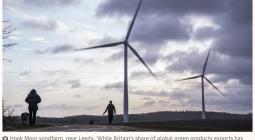Countries could use nature to ‘cheat’ on net zero targets, scientists warn
By relying on natural carbon sinks such as forests and peatlands to offset emissions, governments can appear closer to goals than they actually are
Relying on natural carbon sinks such as forests and oceans to offset continued fossil fuel emissions will not stop global heating, the scientists who developed net zero have warned.
Each year, the planet’s oceans, forests, soils and other natural carbon sinks absorb about half of all human emissions, forming part of government plans to limit global heating to below 2C under the Paris agreement.
But the international group of authors who developed the science behind net zero have warned that countries could “cheat” their way towards Paris targets using naturally occurring parts of Earth’s carbon cycle to make it look as if they achieved net zero while continuing to drive global heating.
The study, published on Monday in Nature and led by the University of Oxford, said that naturally occurring carbon sinks such as rainforests and peatlands must be protected so they can remove historic pollution, but never formed part of the original net zero definition developed by scientists in 2009.
The scientists underscored the need for “geological net zero”, which means any future carbon emissions must be counteracted by permanent removal of the pollution from fossil fuels – not from pre-existing natural ecosystems. They urged governments to urgently clarify what net zero means at Cop29 in Azerbaijan or continue to risk catastrophic climate breakdown.
The rules of the Paris agreement allow countries to claim carbon removals from “managed land” in their territory in their targets towards the goal, such as parts of the Amazon rainforest in Brazil or the taiga forest in Russia. But the net zero researchers said these rules allow countries to take credit for naturally occurring processes that have nothing to do with human emissions.
Conversely, emissions and removals from “unmanaged” land, such as the recent wildfires in Canada that released CO2 equivalent to three times their annual footprint, are not factored into a country’s progress towards the targets.
“We have to protect passive carbon sinks. We have to protect our forests and oceans because we need them to provide that carbon sink service in order for net zero emissions to actually do what we promise people it will do, which is to halt global warming. But we can’t pretend that those passive sinks are somehow compensating for ongoing use of fossil fuels,” said Prof Myles Allen from the University of Oxford’s department of physics, who led the study.
“If you’re still using fossil fuels and still generating carbon dioxide from burning fossil fuels by mid-century, you need to have a plan to put the carbon dioxide they generate back underground or into some equally permanent storage,” he said.
Allen raised concerns that countries could even take credit for natural carbon removal from the sea by claiming “managed oceans”.
“Maybe you will get some countries deliberately using this in a mischievous way: ‘cheating’,” said Dr Glen Peters, of the Cicero Center for International Climate Research in Oslo, a co-author on the paper.
The study comes amid growing concern about the stability of Earth’s carbon sinks, which researchers say temporarily collapsed in 2023 during record temperatures, an El Niño system, and other pressures on ecosystems. The result was that forest, plants and soil – as a net category – absorbed almost no carbon, research found.
Analysis by the research organisation Zero Carbon Analytics has found that the role of nature in nationally determined contributions (NDCs) was a significant blind spot for governments that could make it look as if they were closer than they were to reaching net zero.
An examination of differences in how natural carbon sinks are accounted for in models and NDCs indicated that the budget to limit global heating to below 2C could be 15% to 18% smaller than thought. It also found that the amount of land designated for land-based carbon dioxide removal – such as tree planting – by governments was unrealistic.
“How land is classified in national climate commitments is a critical blind spot in carbon accounting. It allows vast emissions from wildfires and natural disturbances in forests to go uncounted, ultimately misrepresenting progress towards climate goals … Impressive-sounding national climate plans don’t always give a true reflection of progress,” said Joanne Bentley, who led the analysis for Zero Carbon Analytics.
“This is especially problematic when governments over-rely on forests to absorb emissions instead of making the immediate, large-scale changes to industries that are urgently needed,” she said.
Cover photo: The Flow Country, Caithness and Sutherland, Scotland. The 200,000-hectare area’s peat is up to 10m deep, and its soil stores about 100m tonnes of carbon. Photograph: Murdo MacLeod/The Guardian





